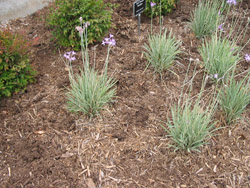Mulch
Mulch is a vapor barrier covering soil in landscape beds. It
can be made of organic or inorganic materials, and in addition to slowing
evaporation it can help suppress weeds, maintain soil temperature levels,
and provide a decorative touch to the bed.
In choosing a mulch, aesthetics is typically the most important concern of a homeowner or landscaper.
A successful water conservation program will educate the final user about
proper application of mulch, and maintenance in order to get the greatest
water savings. Water savings are related to depth of mulch slope of soil,
irrigation system, and proper application – mulch placed too close
to trunks of plants can provide a habitat for pathogens (fungus or molds).
Most suppliers recommend from 1 to 3 inches of mulch on a
highly sloped landscape a hard rain will wash such material off the slope
where slopes occur proper barriers must be installed to hold the mulch, and
heavier materials such as gravels or rocks are recommended.
Rocks and gravel hold heat more than organic mulches. So if
they are used, plant selection must be made with heat tolerance in mind.
Other inorganic mulch products include recycled rubber products. The principle
advantage of inorganic mulches is the fact that organic materials decompose
and must be replaced or added to every year.
Organic mulches include shredded bark, leaves, and chipped
wood. After rainfall mulches can compact, and if anaerobic spaces develop,
a “sour” mulch
with ammonia, or other organic gases can develop which can damage or kill
the plants.13 Mulched beds with
organic materials need regular turning to prevent such anaerobic processes.
Since some types of mulches can hold water, drip or micro irrigation is recommended
sprinkler irrigation which wets the entire mulched bed should be avoided.
|
|
"In choosing a mulch, aesthetics is typically the most important concern of a homeowner or landscaper."

Click to enlarge in separate window. |
|





